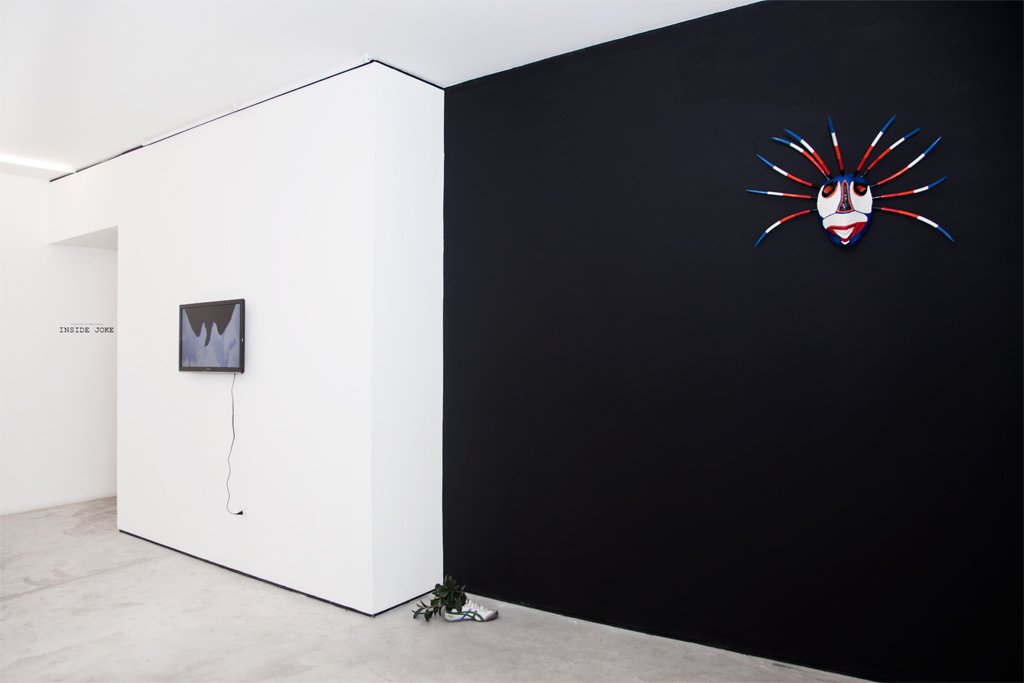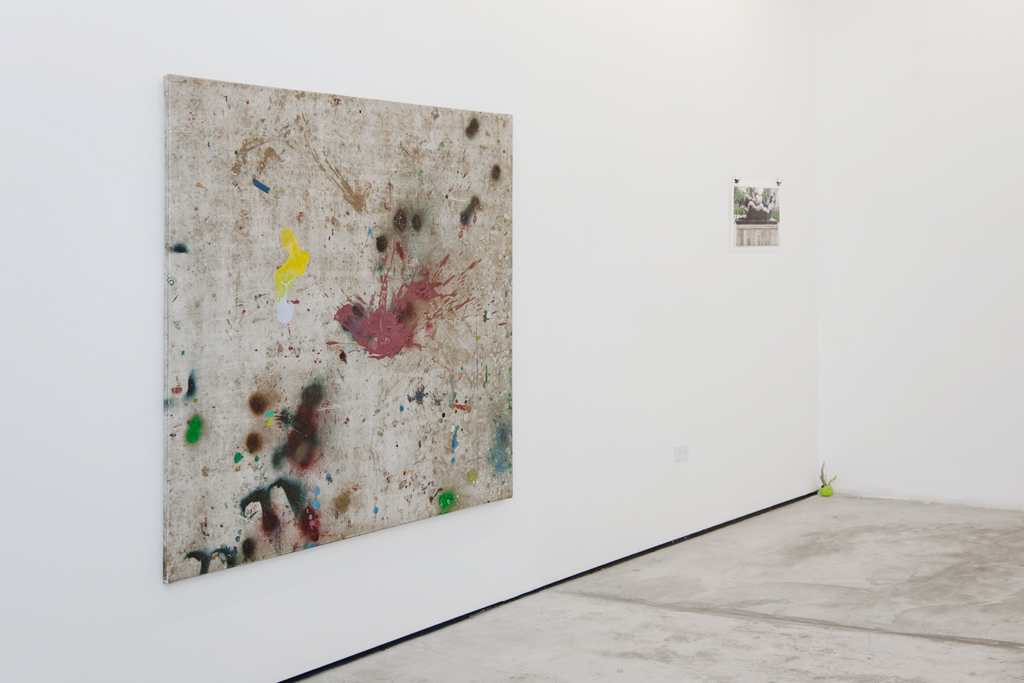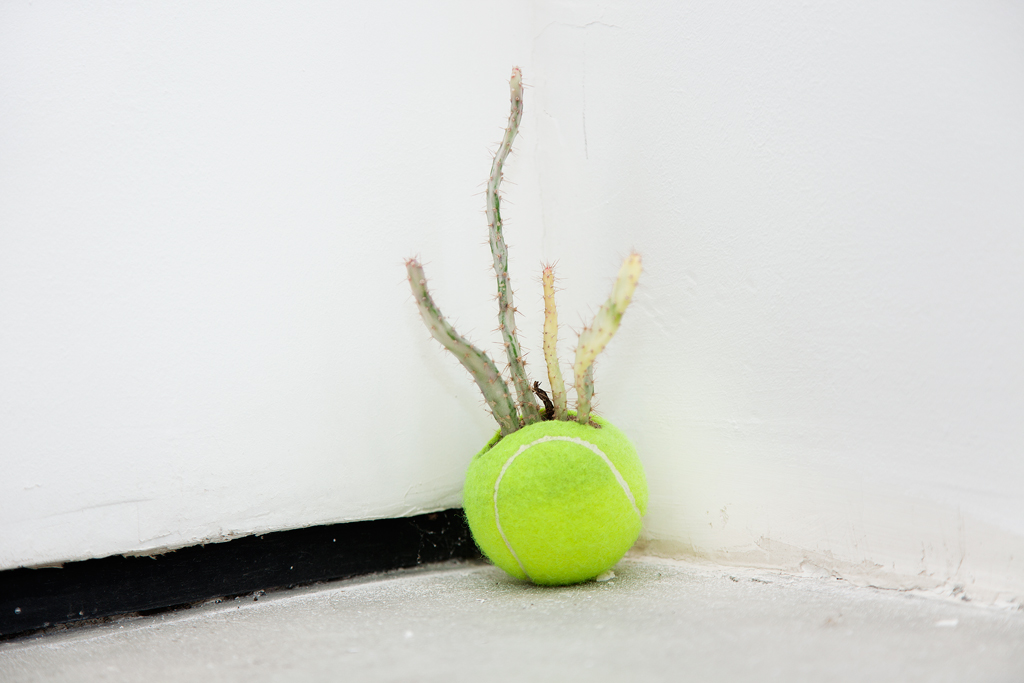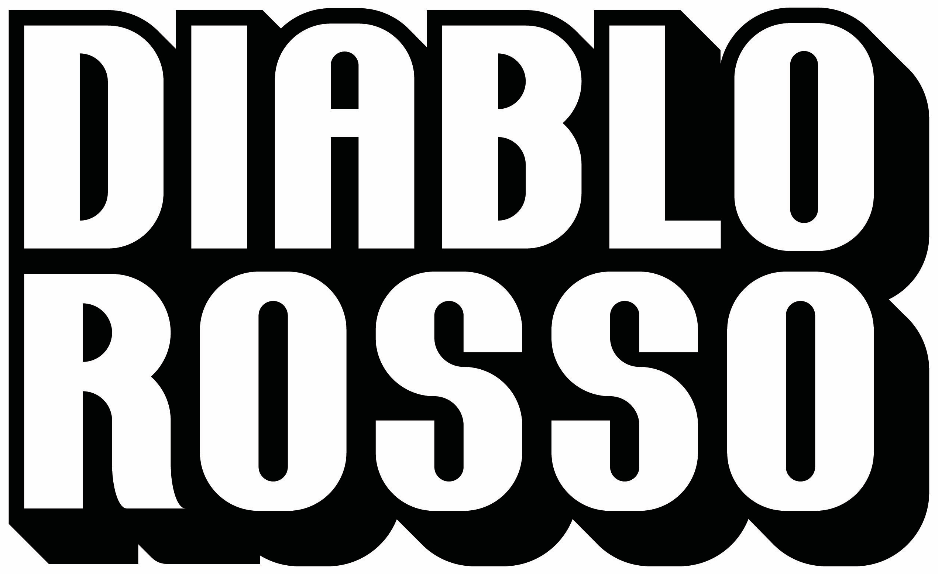FEDERICO HERRERO | JESÚS ‘BUBU’ NEGRÓN | JONATHAN HARKER | RAMADÉS ‘JUNI’ FIGUEROA | STEFAN BENCHOAM & BYRON MÁRMOL | YOSHUA OKÓN
UVUVUV: INSIDE JOKE
group exhibition
feb / 2013
feb / 2013






















Photos : Byron Mármol
Diablo Rosso and Ultraviolet Projects
present:
INSIDE JOKE
"I will not make any more boring art."
- John Baldessari
It is often said that contemporary art is a joke. And what's worse: a joke between friends. Well yes, sometimes it is. The problem is not that it is a joke, or not, and that it is between friends seems rather a good thing to us: it reinforces relationships, collaborations and the desire to work as a team. The problem arises when these jokes are not accessible to everyone, when they do not transcend their nature as inside jokes and serve only to laugh for a while. That is, when it fails to address issues that go beyond the specific circumstances of its creation. But this is not a characteristic of art, but of bad art. Regardless of its origin, contemporary artistic production should connect with other audiences, generate spaces for discussion and laughter; of reflection and well-being. The problem continues when, instead of joining the conversation, telling their own jokes, the audience rejects it for being alien. The invitation is open to everyone, you just have to join in and tell your own jokes. Here are six examples:
1. Upon noticing all the paint spilling on the floor of his studio while he was painting, Federico Herrero covered it with white linoleum to protect it. He soon noticed that the paint residues that fell on it, at random, were just as interesting as those that he placed on his canvases intentionally. What did? He cut out the linoleum from the floor and presented it as a work in the next exhibition in which he was invited to participate.
2. After receiving the invitation from Pablo León de la Barra and Radamés "Juni" Figueroa to participate in the 1st Great Tropical Biennial, Jesús 'Bubu' Negrón went to Playa de Piñones in search of inspiration. While sunbathing, he passed some street vendors selling handmade masks made of dried coconuts. Without thinking twice, he bought some masks and installed them high, among the coconut palms on the same beach where the 1st Great Tropical Biennial was held, and with that gesture he saw himself as the winner of the Golden Pineapple - awarded to the best work of said Biennial.
3. Proyectos Ultravioleta invites Jonathan Harker to create a work for an exhibition that explores the relationship between the United Kingdom and Latin America, to be held in a commercial gallery in London. That same week, while flipping through channels on the television, Harker comes across James Bond: Quantum of Solace. At that moment he has an epiphany: instead of creating a work from scratch for the exhibition, he decides to make a re-edit of the Hollywood film in which he shows only the scenes shot at the Grand Andean Hotel in Bolivia (actually, the National Institute of Culture in Panama) where the protagonists of the film are kindly received by the hotel receptionist, who is actually Emiliano Valdés, one of the members of Proyectos Ultravioleta.
4. After moving to a new apartment, Radamés "Juni" Figueroa saw the need to set it up. I wanted to fill it with plants but I didn't have pots to put them in. One day, while walking to his new home, he came across a pair of used shoes that he soon turned into flower pots. Soon after, he filled his house with all kinds of plants in all kinds of pots, from shoes to deflated soccer balls. Months later, he was invited to participate in a group exhibition and just like that, the tropical ready-made emerged.
5. Walking through the streets of Medellín, Stefan Benchoam and Byron Mármol came across a very nice park full of very ugly sculptures by Fernando Botero. Noting the bodily similarities between Mármol and Botero's monumental sculptures, Benchoam convinced him to allow himself to be photographed with one of them. Warmed up, Mármol took off his shirt, climbed on top of a reclining woman and posed for Benchoam's camera. They uploaded the photo to Facebook and it soon became a viral sensation. Six months later, they were invited to participate in ZONAMACO (a contemporary art fair in Mexico) and presented the photo as "art" for the first time. Mármol's photo on Botero's sculpture was one of the most talked about pieces of the fair.
6. For a long time, Yoshua Okón's pet was a Mexican Aztec dog of the "Xoloitzcuintle" breed. One day, he had the idea of portraying his dog alongside a French Poodle Toy dog, to contrast their differences. She found a very cool lady, with a dog that was just as cool as her, and convinced her to lend it to her for a few hours to do a photo shoot. He went for the dog, took it to his study, and while both dogs were getting comfortable, he left the room to answer a phone call. When he returned, he was surprised to find his dog Xoloitzcuintle perched on top of the French Poodle. Without hesitating for a moment, Okón reached for a digital video camera and recorded a small video of that unlikely scene, which would soon become one of the most iconic works from the beginning of his career.
Diablo Rosso y Proyectos Ultravioleta
presentan:
INSIDE JOKE
"I will not make any more boring art."
- John Baldessari
A menudo se dice que el arte contemporáneo es un chiste. Y lo que es peor: un chiste entre amigos. Pues si, a veces lo es. El problema no es que sea un chiste, o no, y que sea entre amigos nos parece más bien algo bueno: refuerza las relaciones, las colaboraciones y las ganas de trabajar en equipo. El problema surge cuando esos chistes no son accesibles a todos, cuando no trascienden su naturaleza de inside joke y sirven sólo para reirse un rato. Es decir, cuando no logra abordar temas que van más allá de las circunstancias específicas de su creación. Pero esta no es una característica del arte, sino del mal arte. Independientemente de su origen, la producción artística contemporánea debería de conectar con otros públicos, generar espacios de discusión y de risa; de reflexión y de bienestar. El problema continúa cuando, en vez de unirse a la conversación, de contar sus propios chistes, el público lo rechaza por ser ajeno. La invitación está abierta para todos, hay sólo que unirse y contar cada quien sus propios chistes. Aquí van seis ejemplos:
1. Al darse cuenta de toda la pintura que se derramaba en el piso de su estudio mientras pintaba, Federico Herrero los cubrió con linóleo blanco para protegerlo. Pronto notó que los residuos de pintura que caían sobre el mismo, al azar, eran igual de interesantes que los que colocaba en sus lienzos intencionadamente. ¿Qué hizo? Recortó el linóleo del suelo y lo presentó como obra en la siguiente muestra en que lo invitaron a participar.
2. Tras recibir la invitación de Pablo León de la Barra y Radamés "Juni" Figueroa a participar en la 1era Gran Bienal Tropical, Jesús 'Bubu' Negrón se fue a la Playa de Piñones en busca de inspiración. Mientras tomaba el sol, se le atravesaron unos vendedores ambulantes que ofertaban unas máscaras artesanales hechas de cocos secos. Sin pensarlo dos veces, compró unas máscaras y las instaló en alto, entre los cocos de las palmas de la misma playa donde se realizó la 1era Gran Bienal Tropical, y con ese gesto se vio ganador de la Piña de Oro- otorgada a la mejor obra de dicha Bienal.
3. Proyectos Ultravioleta invita a Jonathan Harker a realizar una obra para una exposición que explora la relación entre el Reino Unido y Latinoamérica, a realizarse en una galería comercial Londres. Esa misma semana, mientras va cambiando de canales en el televisor, Harker se topa con la transmisión de James Bond: Quantum of Solace. En ese momento tiene una epifanía: en vez de crear una obra desde cero para la exposición, decide hacer una re-edición de la cinta de Hollywood en la que muestra únicamente las escenas rodadas en el Grand Andean Hotel de Bolivia (en realidad, el Instituto Nacional de Cultura en Panamá) en donde los protagonistas de la película son recibidos amablemente por el recepcionista del hotel, que en realidad es Emiliano Valdés, uno de los miembros de Proyectos Ultravioleta.
4. Luego de mudarse a un departamento nuevo, Radamés "Juni" Figueroa vio la necesidad de ambientarlo. Quería llenarlo de plantas pero no tenía tiestos para colocarlas. Un dia, mientras caminaba a su nuevo hogar, se topó con un par de zapatos usados que pronto convirtió en maceteros. Poco después, llenó su casa con todo tipo de plantas en todo tipo de tiestos, desde zapatos hasta pelotas desinfladas de futbol. Meses después, lo invitaron a participar en una muestra colectiva y alás, surgió el ready-made tropical.
5. Caminando por las calles de Medellín, Stefan Benchoam y Byron Mármol se toparon con un parque muy lindo repleto de esculturas muy feas de Fernando Botero. Notando las similitudes corporales de Mármol y las esculturas monumentales de Botero, Benchoam le convenció a que se dejara retratar con una de ellas. Entrado en calor, Mármol se quitó la camisa, se trepó sobre una mujer recostada y posó para la cámara de Benchoam. Subieron la foto a Facebook y pronto se volvió una sensación viral. Seis meses después, los invitaron a participar en ZONAMACO (una feria de arte contemporáneo en México) y presentaron la foto como "arte" por primera vez. La foto de Mármol sobre la escultura de Botero fue una de las piezas más habladas de la feria.
6. Por mucho tiempo, la mascota de Yoshua Okón fue un perro mexicano azteca de raza "Xoloitzcuintle". Un día, tuvo la idea de retratar a su perro a la par de una perra de raza "French Poodle Toy", para contrastar sus diferencias. Ubicó a una señora muy fresa, con una perrita que era igual de fresa que ella, y la convenció a que se la prestara por unas horas para realizar una sesión de fotos. Fue por la perrita, la llevó a su estudió, y mientras se ambientaban ambos perros, salió de la habitación para atender una llamada telefónica. Cuando volvió, se sorprendió al encontrar a su perro Xoloitzcuintle encaramado sobre la French Poodle. Sin titubear un instante, Okón alcanzó una cámara de video digital y grabó un pequeño video de esa escena tan inverosímil, que pronto se convertiría en una de las obras más icónicas del inicio de su carrera.
Tuesday - Saturday
1-6pm
Sunday
11- 4pm
Closed Monday
1-6pm
Sunday
11- 4pm
Closed Monday

